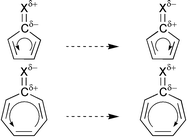Substituent effects on induced current densities in penta- and heptafulvenes
Abstract
Explicit ring-current maps based on distributed-origin coupled Hartree–Fock calculations are constructed for substituted penta- and heptafulvenes CnHnX (n
= 5, 7; X = NH2+, O, NH, CH2, BH2−). The pattern changes from paratropic to diatropic current in the five-membered ring (vice versa for the seven-membered ring) as X changes from strong π


 Please wait while we load your content...
Please wait while we load your content...